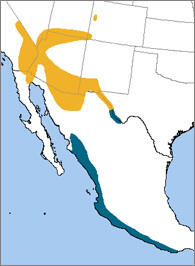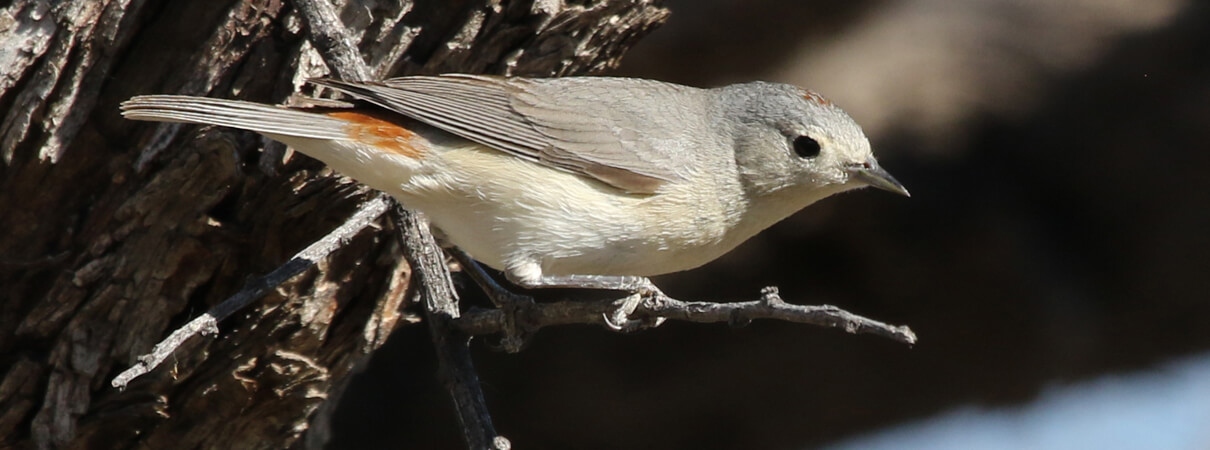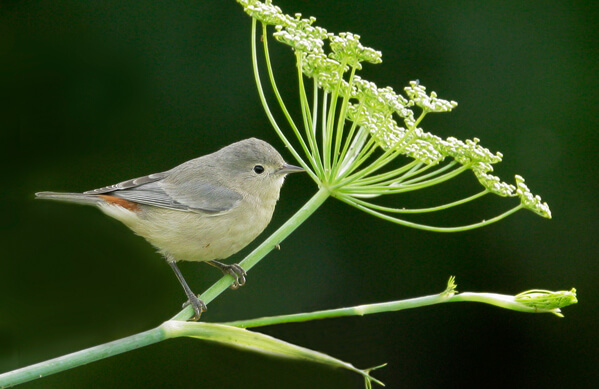 At 4.25 inches, the tiny gray Lucy's Warbler is the smallest North American warbler. It's known as the “desert” or “mesquite” warbler, accurate nicknames for a species that nests almost entirely in the Sonoran Desert. The bird's common name commemorates Lucy Hunter Baird, daughter of ornithologist Spencer Fullerton Baird.
At 4.25 inches, the tiny gray Lucy's Warbler is the smallest North American warbler. It's known as the “desert” or “mesquite” warbler, accurate nicknames for a species that nests almost entirely in the Sonoran Desert. The bird's common name commemorates Lucy Hunter Baird, daughter of ornithologist Spencer Fullerton Baird.
Like the Southwestern Willow Flycatcher and western population of Yellow-billed Cuckoo, Lucy's Warbler is most threatened by loss and degradation of streamside nesting areas due to groundwater pumping and invasive plants.
Some populations are also affected by cowbird parasitism.
Cavity-nesting Warbler
The Lucy's Warbler is one of only two North American warblers that nests in cavities. (The Prothonotary Warbler is the other.) Unlike many cavity-nesting species, Lucy's Warblers have not been commonly known to use nest boxes, although some experimental work shows that they may use artificial nest sites under appropriate conditions.
(Our partner Tucson Audubon reports some success and provides plans for Lucy's Warbler nest boxes.)
Males court females by spreading their wings to show the chestnut rump patch and sometimes raising their chestnut crowns. They establish territories by singing, threat displays (raising their crowns and flicking tails), and even fights.
Lots of Lucy's
Nesting in some of the densest concentrations of any warbler, as many as five breeding pairs can be found per acre in optimal habitat. Pairs build their nests in natural tree or cacti cavities, deserted woodpecker holes, or behind loose bark. Occasionally they use deserted nests of other bird species, including Verdin and thrashers.
Sign up for ABC's eNews to learn how you can help protect birds
The birds build their nests with fine grasses and weeds, strips of bark, and the leaf stems of mesquite trees. If using a woodpecker hole, they may fill the cavity nearly to the top with debris and put the nest on top, permitting a view for the nesting birds inside.
The female does most of the incubation, but both parents forage for food and help to raise the young. This species can raise several broods per nesting season.

Lucy's Warbler, Arizona. Photo by Chris Hill, Shutterstock
Early Birds Beat the Heat
Lucy's Warblers migrate to and from their breeding grounds earlier than other birds, which is thought to be a strategy for avoiding the most extreme seasonal temperatures. Although this species is adapted to a hot climate, it is still vulnerable to the extreme heat, drought, and rainfall increasingly associated with climate change.
Like other warbler species, including the Golden-winged Warbler and American Redstart, Lucy's Warbler is an active forager. The birds busily glean leaves and flower clusters for insects and small arthropods, including leafhoppers, caterpillars, beetles, and spiders. The birds are known to beat hairy caterpillars against a hard surface; presumably this makes them more palatable!
Help for Birds of the Southwest
ABC continues work to preserve riparian habitat in the southwest United States to benefit an entire suite of migratory birds that includes Lucy's Warbler along with Black-capped Vireo and Rufous Hummingbird.
Among our efforts is advocating for the San Pedro River, which runs through the Sonoran Desert and is one of the last major undammed rivers in the American Southwest. A 28,000-home project planned for Benson, Ariz., could have a significant impact on the San Pedro and threatened wildlife that depend on it; as of now, objections raised by conservationists have temporarily halted the project.
The San Pedro Riparian National Conservation Area protects critical habitat for this warbler as well as species such as Elf Owl and Costa's Hummingbird. It was the first site designated by ABC as a Globally Important Bird Area and represents a rare remnant of what was once an extensive network of riparian systems throughout the southwest.
Donate to support ABC's conservation mission!



















































